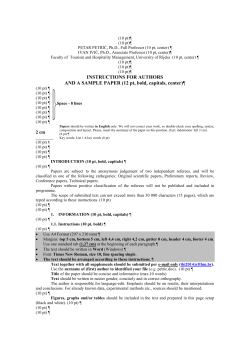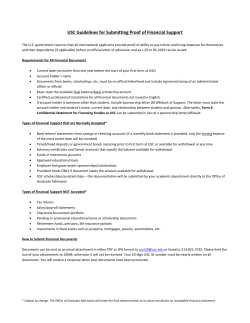
Document 255522
‘.. ‘FROM . : BOLD SPRINGS INC PC PHONE NO. : 54E1953199El Jan. 27 1998 D4:34PM PI %x covgr sheet: - cover sheet plus FOUR page document To: IX, Meg Oeller ‘LjQ,i/\!j30 HZ:43 FDA/Center for Veterinary Medicine, I-WY‘-30 Standish .Place Rockville, MD 20855 From: Dr. (hrethMoore Route 1, Box 139 Pembroke, VA 24136 Sorry for leaving this till the last minute. Hope you get a chance to read it before discussing it tomorrow! Thanks, & w 57 . ‘FROM . : BOLD SPRINGS INC PC PHONE NO. : 54a95319913 Jan. 27 1996 04:35PM (Mmments f-mm Gare(h A. Moore, DVM, MS, Dip (ABVP) Dmg and 13iolugics Availability Commi l& Chiiltmiin American Association of Small Ruminant Practitioncm cm CVA4H?A ‘s: “PROPOSALS TO INCREASE TI HZAVAILA131LITT OF APPROVED DRUGS FOR MINOR SPECIES AND MINOR USES” ANIMAL As a group the American AssociaLiun uf Small Ruminant Pmclitionen are significantly affcc~d by the on going problem of drug availability in mirsrsrand exotic species. Recent ]egishsLive action (AMDUCA and ADAA) of_fersthe possi bility c~fdramatic change with rcgad to this situation. Ongoing efforts by the CVM/FDA to potential y improve drug availability for We species we deal with are appreciated, As to specific comments on the recent proposal: Section I; A) This preamble seems to impl y llml minor spccics wc mamtained more for novelty value rather than as production species, While this may bc Q-UCfor species maintained in zoological parks it is most certainly not tme for the various aquatic and bird spccics farmed for food or for sheep and goiat breeds producing meat, milk and fiber. While the economic impacl of the so-called major speciex is greater than these minor species tic lattm do contribute a significant amount to the national economy. Section 1; B) The crmcept of ELUD by veterinarians shuuld be maintained in some form. As witi the human medical @mmunity there am always going to be situtilions where knowledge outstrips the approval process and ef’fedive treatments will involve drug use that is not discussed cm the pruduct label. But as with Lhehuman medical community such use should always be supervised by a licensed pmctiti cmer. Since the current ELUD provisions do not allow for use of drugs except in an effort 10 “relieve pain and suffering in a patient” some provision must be made to appu-we the use of certain production enhancing pixdrrnaceutical agents in minor species. Section should nccdcd “major 1; C) I%arapolation of data between species for lhe purpose of label drug approval be a “doable” pmccss. Perhaps Iimitcd, low cost cmfirmatoty tria!s would be bul iLshould work. Final clarification of the, “sheep as a minor species” rather than for human food safety and minor for species approval”, situation must be made. Section I; D) The move for change on the part of the CVMFDA is appreciatcct Section III; A) See comment on Section l; Clabove. Section HI; B} Supplemental approvals idso should be a method that works to improve minor species and minor use drug availability. NRSP-7 funded studies have pruduced useful information but the~ often smms to bc u Lime lag or complete failure in moving from the study to an appropriate change cm the product label. Section III; C) No question, drug manufacturing for minor species andjor minor uscs must meet the same guidelines as for major spccics use, Section 111;D) Defining non-food life stages for livestock species, for example breeding age populations, probably would not be a gcod idea since the possibility “always exists that animals classified as such could cnd up being processed for human rood. Section 111;E) Harmonization of inkxnationai regulatory matters should occur. All the major pha.rrnaceutiml companies are intcrnatiomd corpomtions and global trude in foods of 1 P2 .,,, . . “FROM . . : BOLD SPRINGS INC PC PHONE NO. : 5409531990 Jan. 27 1998 g4:35PM mimaJ(}rigin alesignifiwt. Much exLr~lakl dl’uguse inthc~t has bwnbased(}na drug sponsor’s studies conducted to gain apprwal for a” minor” spccics in rmothcr counLry, Acxxptancc of such studies k) allow labeling of pmclucts in this country would go a long way towards eliminating minor species /minor use problems, Section IH; F’) NRSP-7 is a systcrn that seems to work to generate uscfid data on drug use in minor species and minor use situations. As stated above, the problcm seems m lie in moving from the NRSP-7 sponsored study to a product label with an approved use cm it. A slight problem wi~h the NRSP-7 programs has been ii’s legislated emphasis on research involving drugs used for disease treiit.ment rather than discme prevention and production enhancement. Section III; G) Clarification of the exact status of sheep, as a minor verses majodminor species,, should be addressed in his area. Section IV; A) The possibility of extrdabel drug use under the supcrvisicm of a vcterinafian must be maintained. Restrictions to ensure the safety of human foods must be in place but no drug approval process can meet pharmaceutical needs for all cond.itiohs in all species under all circums(anccs. Modifications to labeled indications should minimize the ned for such cxtralabcl usc but such modifications must meet the needs of the animal industry with regard to pharnmccuticals in feed and for prudud.icm enhu.ncing chug use in certain ,spe.ties. Since the use of antibiotics in the major spwies is apparently a risk in the development of antimicrobial resistance control measures put in place to minimize that risk should ‘beeffective if’applied to such use in minor spccics. If approvals for mi nor species/ minor uses are not forth coming during the first half-of the sunset period this issue would have to be addressed again. It would bc hoped that other provisions in this proposal would encourage drug companies w seek such approvtd~ including those relating to production enhancing agents such as growth promotants and reproductive regulators Section IV; B) The described methods w cflcxt the removal of disincentives should help ertcouragc the drug companies to seek approvals. But congrwsional action to allow removal of a particular drug from the market solely for lack of a FDA approval seems a bit drastic. Over the past 30 years the FDA has removed many dregs, seemingly at an increasing pace, from tie A mcrican and world veterinary markets wi thcmt such legislation a,rKIincreascd lcgislati ve power to achicvc such an end seems unnecessary. Section IV; C) NRSP-7 is a good progmm except for the apparent problem of moving from the development of research data to actuall y adding a minor specieshninor usc approval to a manufacturer’s label. Could it do better with inure money - probabi y yes. Could current governmcmt funding be improved if all available resources wem evaluated and applied to the most effective prograrn(s?) - ccrtai nly yes. Do we need another level of administmtion or a pma.llci agrmcy lo do this - dcfiniti vel y NO. Work with what you have and t-direct or increase funding to whom er is doing the most efi-ectivc job. Expand and/or redefine the guide~ines of the NRSP-7 program to allow its research money to be spent on production enhancement drugs (reproductive regulators and disease prevention agents - including vaccines??) not just a.ntimiembial treatment drugs. Database development should bean important aspect of expanding minor species/minor use drug availability. It should also be an important aspect of main~ining the safety of such USC. If pmctit.ioncrs seeking methods of treatment for spwific conditions could be provided with an-rent, scientificallyy accurate informati(m on the usc of a pwticular drug including human hc..zdthrisks, withdrawal times, ck. then the likchlmod of its safe use would be much increased. 2 P3 ‘FROM : BOLD SPRINGS (jurc(hA, AASKP INC M(MMU PC PHONE NO. : 5409531990 Jan. 27 1998 D4:36PM Comnlenrs on Minor Species/ PITIp WI Mfnor I_LwsCV&j/FDA Sources of information for such a Mabase could include: - infcmnalivn from a sponsor’s initial drug development (gained through KIT WLaction ifnot available any other way); - any NRSP-7 information (gained from Public Master Fi Ics m f“romfunded academic or industry resemchcm); - FARAD database; - T.JSPhuman and vebwioary drug databases; some tie in to intcmatiomd duu wm.ilablc (again drug sponsor’s files, Codex Veterinaries, WHO data, . ..). - CDC’S or NVSL’s databases on antimicrobial susceptibility testing, to increase awarermss of potential resists.tw problems; ... To be COS1effeztivc such a database should probably be established as a website on the world wide web. Such a wcbsit.e would be useful to practicing veterinarians researching effective treatments and to individuals or companies seeking potential opportunities h>profit from expanded drug upprovals. But if such a website is to be successful it must be managed well and kept up bndate even if that involves contmeting the maintenance ofxuch a site to an outside agency with greater computer expertise. Section IV; D) Since the phwrnaceutical industry is profit driven some type of financial incentive to encourage seeking additional approvals for their products is probably needed, But in getting a product approved for major species wc such companies must have determined that thal market alone was sufficient to make a profit othenvise ,p-oduct development wm.&i have been halted. Since additional sales of a drug through a change in label indications for minor specicdusets presumably increases profits then the ~mpany should mllaborate by providing at Iemt sume research funding (money or facilities) k) gain the information ~cquired for such addi ticms. Making such costs for minor spccieduses development tax deductible should be a reasonable inccnt.ivc. However since government money, funding from NRSP-7 or CVM/FDA assistance for e~~mple, is pldwbly going to be used in gaining additional Mel indications then any additional profit potential for the sponsoring company should be examined carcfull y. The gmnting of expanded exclusivity (citier use or time based) maybe too costly an incentive. As is noted in tic proposzzl such a step mxdd effectively increase the cost of a drug to the vclcrinarian and prcxlucer thereby potcntiall y limiting its usefulness. Section IV; E) Tie such data shting requirements into the dcwelopment of the minor species/uses database, The company should skux.1behind any labeled uscs buL how to protect the animal owner from loss or tic prew-ibing vcterinwim from liability would remain a problem, (1 suppose them’s no possibility for reestablishing tic concept of informed risk in the cumnl lawsuit-driven American society.) Scctic-mW; F) The existence of a minor specimluses database and the continued, we!! regulated policy of extra label drug use should make the dedopment of a minor use cawgory or orphan vcterirmry drug classification unnecessary. Section, IV: (3) From the sheep and goat practitioner’s standpoint the idea that a drug which achieves special non-food, minor species apprwal is then excluded fmn use in food producing minor species under any circumstances is wonying, That may not be ~he way the CVIWFDA intends that this proposal be applied but it could be the way it is interpreted. Section IV; K) Arty such review would require CVMHJA cwcrsight but why lixniLthe potential for such expert review to non-food minor species. P4 g-~oM : BOLD SP;INGS INC PC PHONE NO. : 54D953199EI Jan. 27 1998 04:37PM Section IV; J) As commented above. data generated internaticmall y to gain drug approvals related to minor qxxies/uses situations (as defined by the CVM/FDA) should be eligible for rmuew by the CVMWDA with the pokmtitd w add portions of the foreign approved label m the product marketed in the ‘United States. Any mcxhimism, suitable reviewed, Chal siJPpI ifies .wmh label changes should be considerai. Sincere] y, Gweth A, Moore, DVM, MS, Dip (ABVP) Route 1, BOX 139 Pembroke, VA 2A136 (home). 1-540-552-1.991 (work) 1-540-626-3455 P5
© Copyright 2025





















